Exploring the Socio-Economic and Environmental Impact of Tourism
VerifiedAdded on 2023/06/09
|9
|2085
|398
Report
AI Summary
This report provides a comprehensive analysis of the development and impacts of contemporary tourism. It discusses the economic, environmental, and socio-cultural effects, both positive and negative, that tourism has on a country. The report highlights job creation and increased demand for local crafts as positive economic impacts, while also acknowledging the negative impacts of increased carbon footprint and decreased traditional employment. Environmental impacts include better water quality and natural resource protection, alongside concerns about ocean health and resource overuse. Socio-cultural impacts range from increased cultural knowledge and community support to rising crime rates and the potential for cultural shifts. The report concludes that tourism has significant impacts and its sustainable management is crucial for future economic stability, environmental protection, and cultural preservation. Desklib offers similar solved assignments for students.
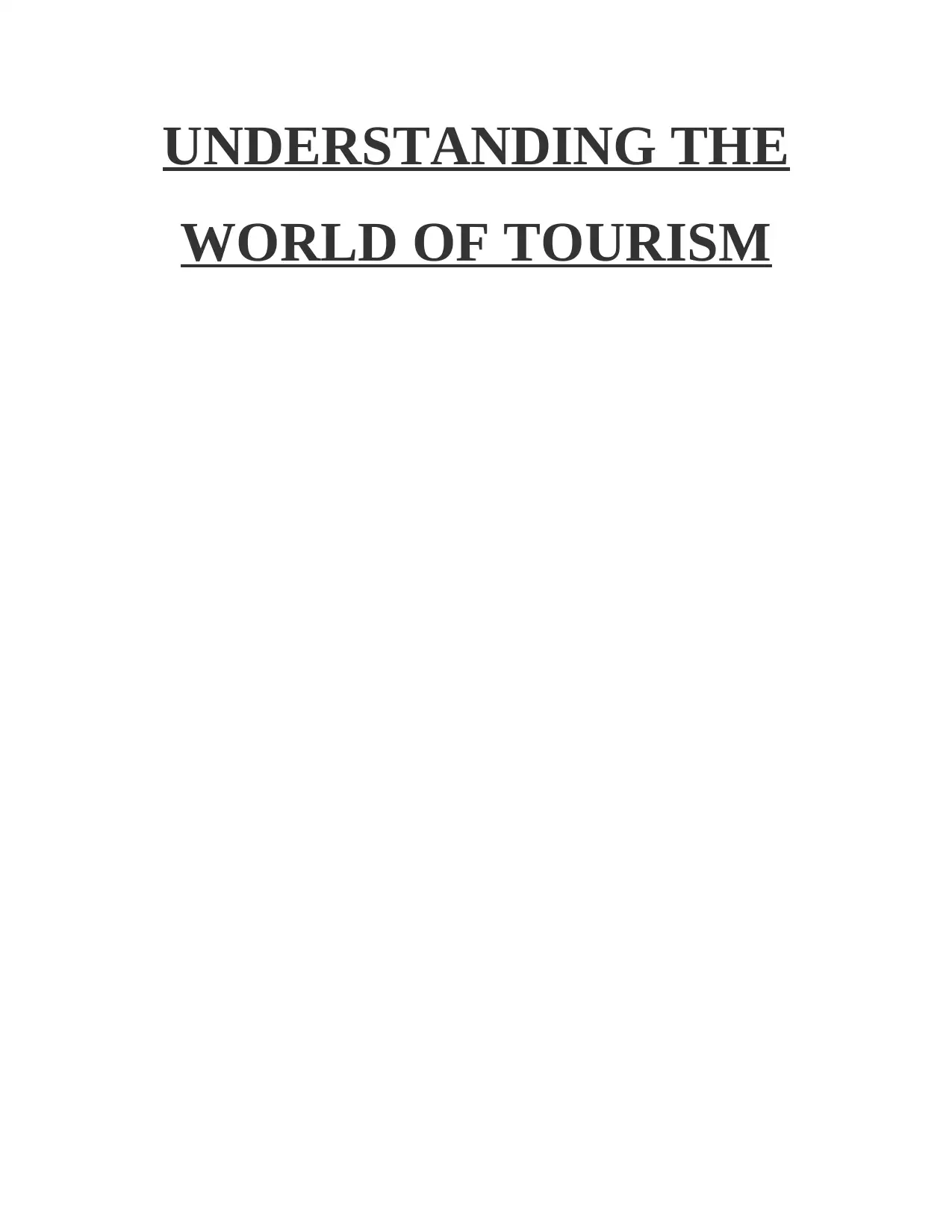
UNDERSTANDING THE
WORLD OF TOURISM
WORLD OF TOURISM
Paraphrase This Document
Need a fresh take? Get an instant paraphrase of this document with our AI Paraphraser
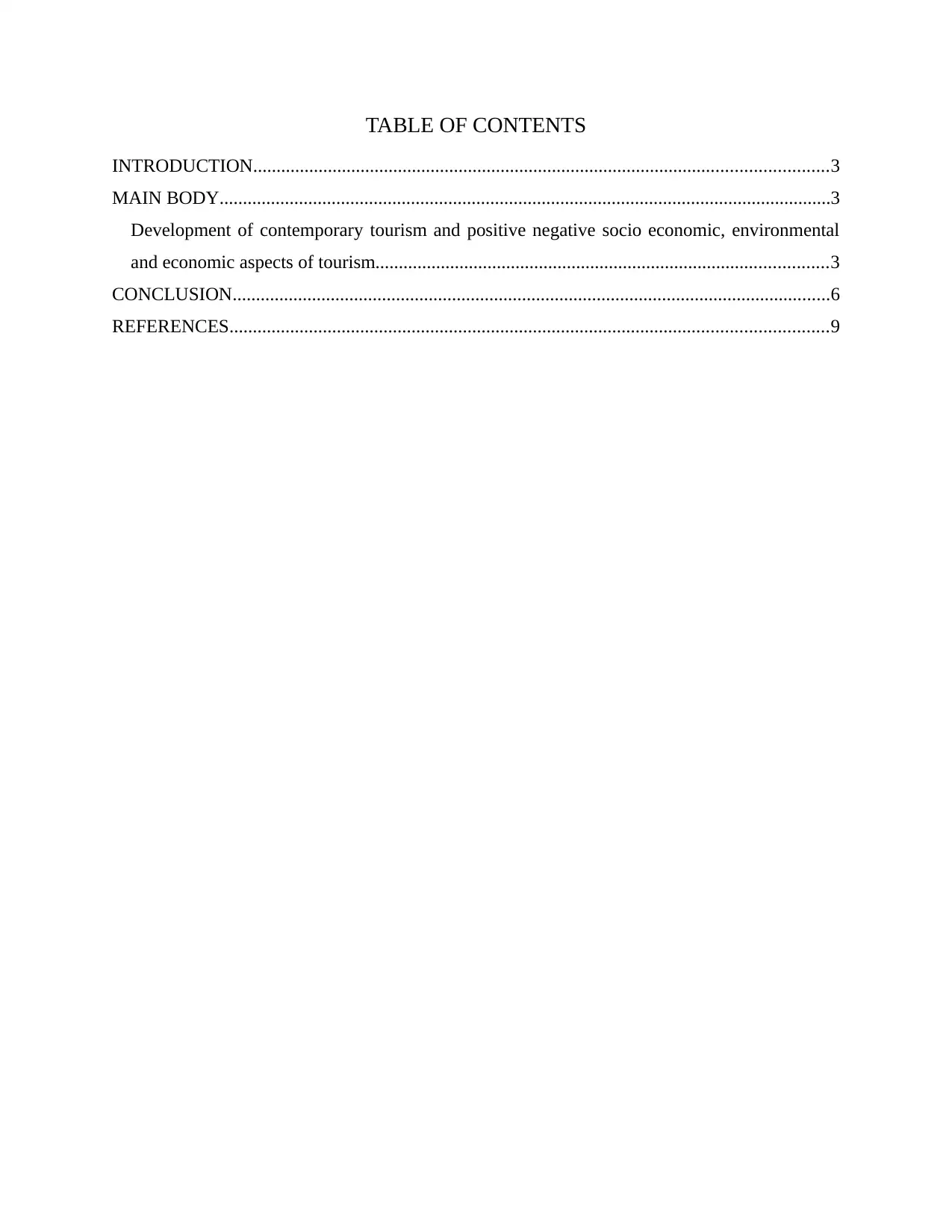
TABLE OF CONTENTS
INTRODUCTION...........................................................................................................................3
MAIN BODY...................................................................................................................................3
Development of contemporary tourism and positive negative socio economic, environmental
and economic aspects of tourism.................................................................................................3
CONCLUSION................................................................................................................................6
REFERENCES................................................................................................................................9
INTRODUCTION...........................................................................................................................3
MAIN BODY...................................................................................................................................3
Development of contemporary tourism and positive negative socio economic, environmental
and economic aspects of tourism.................................................................................................3
CONCLUSION................................................................................................................................6
REFERENCES................................................................................................................................9
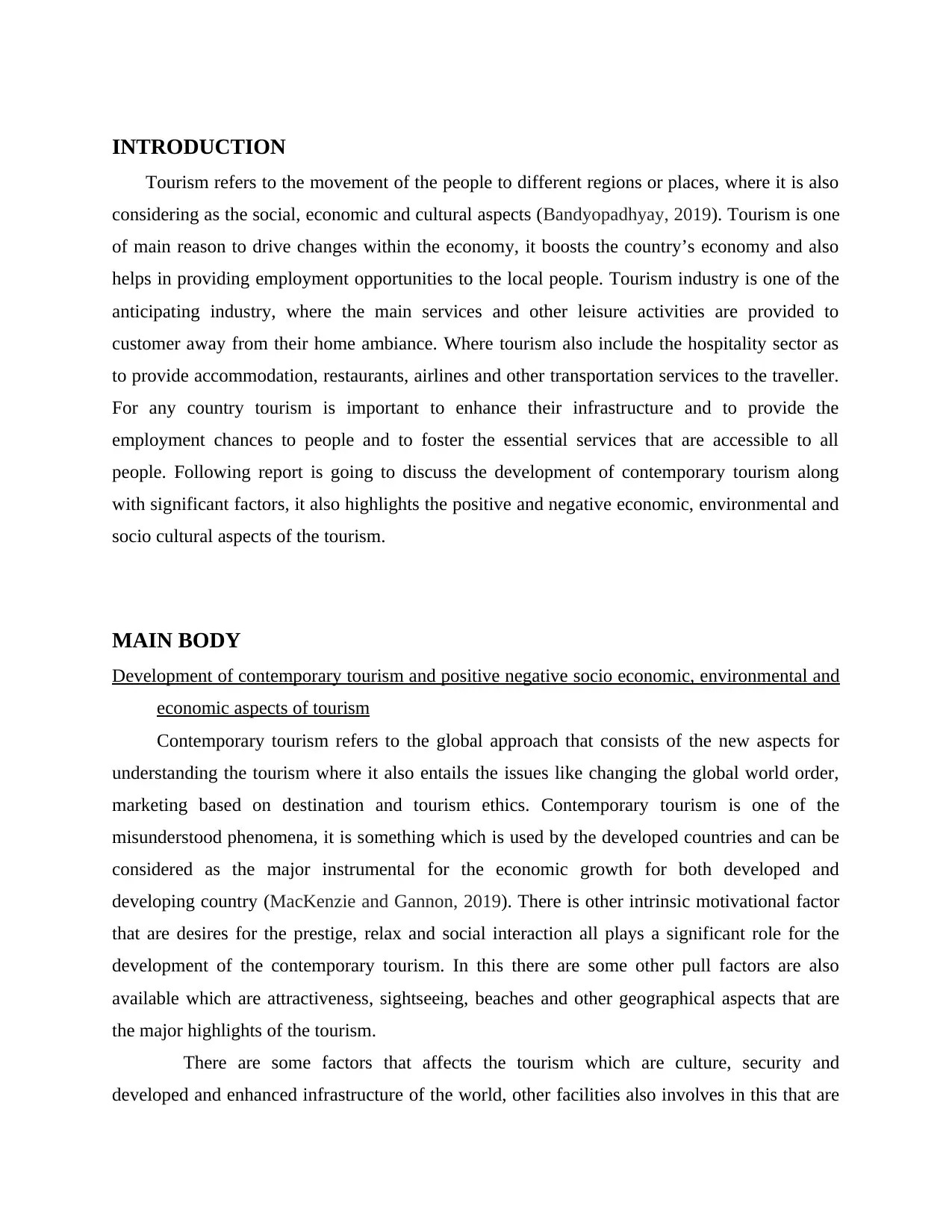
INTRODUCTION
Tourism refers to the movement of the people to different regions or places, where it is also
considering as the social, economic and cultural aspects (Bandyopadhyay, 2019). Tourism is one
of main reason to drive changes within the economy, it boosts the country’s economy and also
helps in providing employment opportunities to the local people. Tourism industry is one of the
anticipating industry, where the main services and other leisure activities are provided to
customer away from their home ambiance. Where tourism also include the hospitality sector as
to provide accommodation, restaurants, airlines and other transportation services to the traveller.
For any country tourism is important to enhance their infrastructure and to provide the
employment chances to people and to foster the essential services that are accessible to all
people. Following report is going to discuss the development of contemporary tourism along
with significant factors, it also highlights the positive and negative economic, environmental and
socio cultural aspects of the tourism.
MAIN BODY
Development of contemporary tourism and positive negative socio economic, environmental and
economic aspects of tourism
Contemporary tourism refers to the global approach that consists of the new aspects for
understanding the tourism where it also entails the issues like changing the global world order,
marketing based on destination and tourism ethics. Contemporary tourism is one of the
misunderstood phenomena, it is something which is used by the developed countries and can be
considered as the major instrumental for the economic growth for both developed and
developing country (MacKenzie and Gannon, 2019). There is other intrinsic motivational factor
that are desires for the prestige, relax and social interaction all plays a significant role for the
development of the contemporary tourism. In this there are some other pull factors are also
available which are attractiveness, sightseeing, beaches and other geographical aspects that are
the major highlights of the tourism.
There are some factors that affects the tourism which are culture, security and
developed and enhanced infrastructure of the world, other facilities also involves in this that are
Tourism refers to the movement of the people to different regions or places, where it is also
considering as the social, economic and cultural aspects (Bandyopadhyay, 2019). Tourism is one
of main reason to drive changes within the economy, it boosts the country’s economy and also
helps in providing employment opportunities to the local people. Tourism industry is one of the
anticipating industry, where the main services and other leisure activities are provided to
customer away from their home ambiance. Where tourism also include the hospitality sector as
to provide accommodation, restaurants, airlines and other transportation services to the traveller.
For any country tourism is important to enhance their infrastructure and to provide the
employment chances to people and to foster the essential services that are accessible to all
people. Following report is going to discuss the development of contemporary tourism along
with significant factors, it also highlights the positive and negative economic, environmental and
socio cultural aspects of the tourism.
MAIN BODY
Development of contemporary tourism and positive negative socio economic, environmental and
economic aspects of tourism
Contemporary tourism refers to the global approach that consists of the new aspects for
understanding the tourism where it also entails the issues like changing the global world order,
marketing based on destination and tourism ethics. Contemporary tourism is one of the
misunderstood phenomena, it is something which is used by the developed countries and can be
considered as the major instrumental for the economic growth for both developed and
developing country (MacKenzie and Gannon, 2019). There is other intrinsic motivational factor
that are desires for the prestige, relax and social interaction all plays a significant role for the
development of the contemporary tourism. In this there are some other pull factors are also
available which are attractiveness, sightseeing, beaches and other geographical aspects that are
the major highlights of the tourism.
There are some factors that affects the tourism which are culture, security and
developed and enhanced infrastructure of the world, other facilities also involves in this that are
⊘ This is a preview!⊘
Do you want full access?
Subscribe today to unlock all pages.

Trusted by 1+ million students worldwide
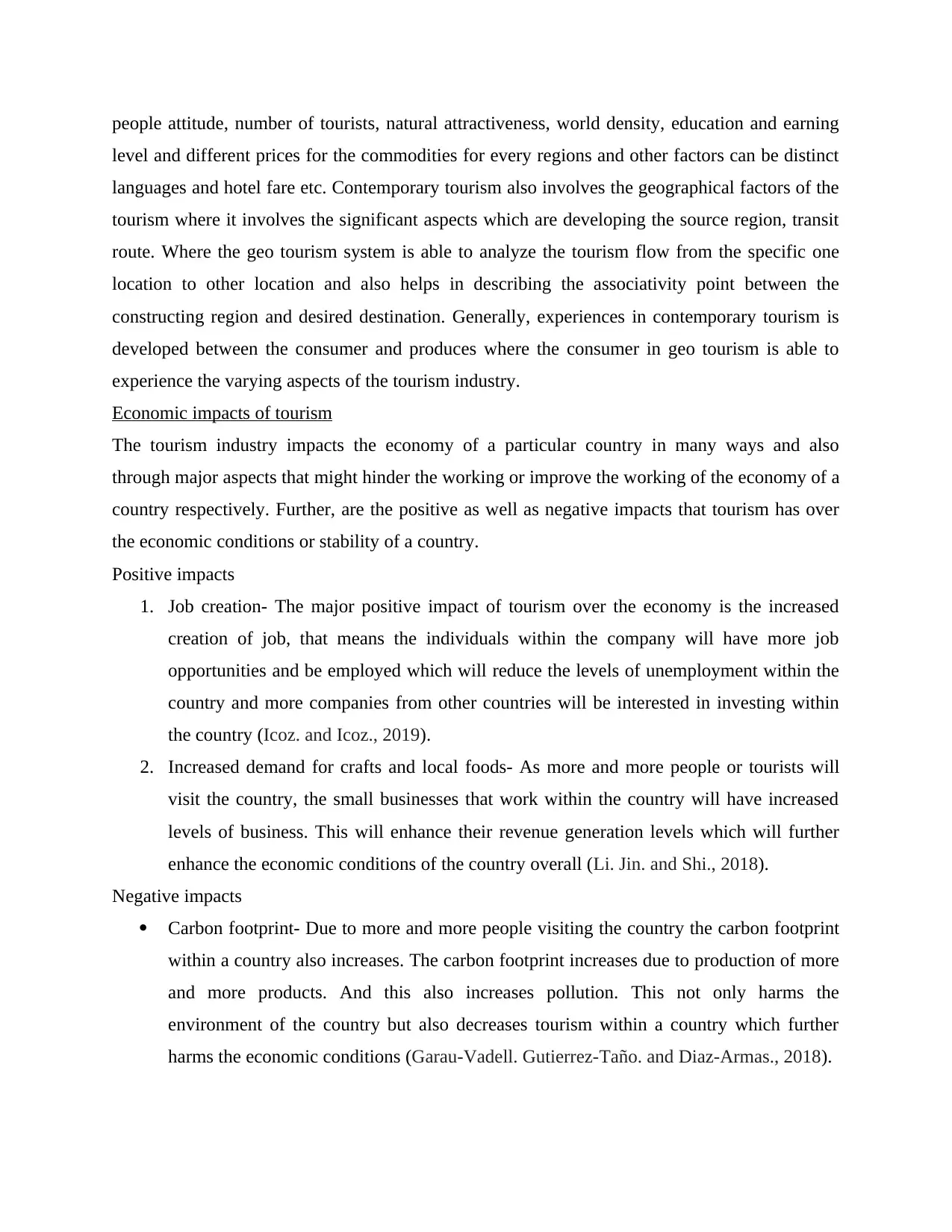
people attitude, number of tourists, natural attractiveness, world density, education and earning
level and different prices for the commodities for every regions and other factors can be distinct
languages and hotel fare etc. Contemporary tourism also involves the geographical factors of the
tourism where it involves the significant aspects which are developing the source region, transit
route. Where the geo tourism system is able to analyze the tourism flow from the specific one
location to other location and also helps in describing the associativity point between the
constructing region and desired destination. Generally, experiences in contemporary tourism is
developed between the consumer and produces where the consumer in geo tourism is able to
experience the varying aspects of the tourism industry.
Economic impacts of tourism
The tourism industry impacts the economy of a particular country in many ways and also
through major aspects that might hinder the working or improve the working of the economy of a
country respectively. Further, are the positive as well as negative impacts that tourism has over
the economic conditions or stability of a country.
Positive impacts
1. Job creation- The major positive impact of tourism over the economy is the increased
creation of job, that means the individuals within the company will have more job
opportunities and be employed which will reduce the levels of unemployment within the
country and more companies from other countries will be interested in investing within
the country (Icoz. and Icoz., 2019).
2. Increased demand for crafts and local foods- As more and more people or tourists will
visit the country, the small businesses that work within the country will have increased
levels of business. This will enhance their revenue generation levels which will further
enhance the economic conditions of the country overall (Li. Jin. and Shi., 2018).
Negative impacts
Carbon footprint- Due to more and more people visiting the country the carbon footprint
within a country also increases. The carbon footprint increases due to production of more
and more products. And this also increases pollution. This not only harms the
environment of the country but also decreases tourism within a country which further
harms the economic conditions (Garau-Vadell. Gutierrez-Taño. and Diaz-Armas., 2018).
level and different prices for the commodities for every regions and other factors can be distinct
languages and hotel fare etc. Contemporary tourism also involves the geographical factors of the
tourism where it involves the significant aspects which are developing the source region, transit
route. Where the geo tourism system is able to analyze the tourism flow from the specific one
location to other location and also helps in describing the associativity point between the
constructing region and desired destination. Generally, experiences in contemporary tourism is
developed between the consumer and produces where the consumer in geo tourism is able to
experience the varying aspects of the tourism industry.
Economic impacts of tourism
The tourism industry impacts the economy of a particular country in many ways and also
through major aspects that might hinder the working or improve the working of the economy of a
country respectively. Further, are the positive as well as negative impacts that tourism has over
the economic conditions or stability of a country.
Positive impacts
1. Job creation- The major positive impact of tourism over the economy is the increased
creation of job, that means the individuals within the company will have more job
opportunities and be employed which will reduce the levels of unemployment within the
country and more companies from other countries will be interested in investing within
the country (Icoz. and Icoz., 2019).
2. Increased demand for crafts and local foods- As more and more people or tourists will
visit the country, the small businesses that work within the country will have increased
levels of business. This will enhance their revenue generation levels which will further
enhance the economic conditions of the country overall (Li. Jin. and Shi., 2018).
Negative impacts
Carbon footprint- Due to more and more people visiting the country the carbon footprint
within a country also increases. The carbon footprint increases due to production of more
and more products. And this also increases pollution. This not only harms the
environment of the country but also decreases tourism within a country which further
harms the economic conditions (Garau-Vadell. Gutierrez-Taño. and Diaz-Armas., 2018).
Paraphrase This Document
Need a fresh take? Get an instant paraphrase of this document with our AI Paraphraser
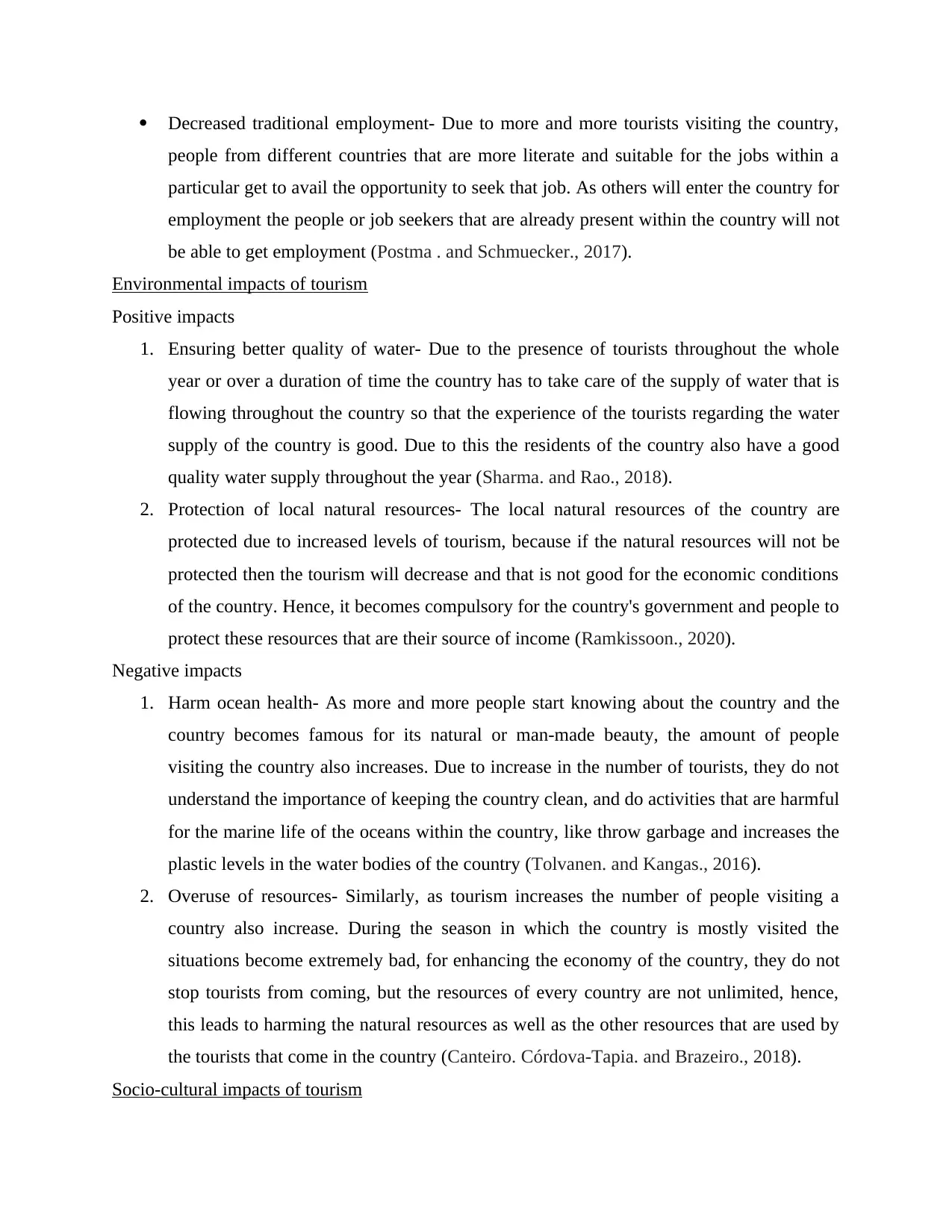
Decreased traditional employment- Due to more and more tourists visiting the country,
people from different countries that are more literate and suitable for the jobs within a
particular get to avail the opportunity to seek that job. As others will enter the country for
employment the people or job seekers that are already present within the country will not
be able to get employment (Postma . and Schmuecker., 2017).
Environmental impacts of tourism
Positive impacts
1. Ensuring better quality of water- Due to the presence of tourists throughout the whole
year or over a duration of time the country has to take care of the supply of water that is
flowing throughout the country so that the experience of the tourists regarding the water
supply of the country is good. Due to this the residents of the country also have a good
quality water supply throughout the year (Sharma. and Rao., 2018).
2. Protection of local natural resources- The local natural resources of the country are
protected due to increased levels of tourism, because if the natural resources will not be
protected then the tourism will decrease and that is not good for the economic conditions
of the country. Hence, it becomes compulsory for the country's government and people to
protect these resources that are their source of income (Ramkissoon., 2020).
Negative impacts
1. Harm ocean health- As more and more people start knowing about the country and the
country becomes famous for its natural or man-made beauty, the amount of people
visiting the country also increases. Due to increase in the number of tourists, they do not
understand the importance of keeping the country clean, and do activities that are harmful
for the marine life of the oceans within the country, like throw garbage and increases the
plastic levels in the water bodies of the country (Tolvanen. and Kangas., 2016).
2. Overuse of resources- Similarly, as tourism increases the number of people visiting a
country also increase. During the season in which the country is mostly visited the
situations become extremely bad, for enhancing the economy of the country, they do not
stop tourists from coming, but the resources of every country are not unlimited, hence,
this leads to harming the natural resources as well as the other resources that are used by
the tourists that come in the country (Canteiro. Córdova-Tapia. and Brazeiro., 2018).
Socio-cultural impacts of tourism
people from different countries that are more literate and suitable for the jobs within a
particular get to avail the opportunity to seek that job. As others will enter the country for
employment the people or job seekers that are already present within the country will not
be able to get employment (Postma . and Schmuecker., 2017).
Environmental impacts of tourism
Positive impacts
1. Ensuring better quality of water- Due to the presence of tourists throughout the whole
year or over a duration of time the country has to take care of the supply of water that is
flowing throughout the country so that the experience of the tourists regarding the water
supply of the country is good. Due to this the residents of the country also have a good
quality water supply throughout the year (Sharma. and Rao., 2018).
2. Protection of local natural resources- The local natural resources of the country are
protected due to increased levels of tourism, because if the natural resources will not be
protected then the tourism will decrease and that is not good for the economic conditions
of the country. Hence, it becomes compulsory for the country's government and people to
protect these resources that are their source of income (Ramkissoon., 2020).
Negative impacts
1. Harm ocean health- As more and more people start knowing about the country and the
country becomes famous for its natural or man-made beauty, the amount of people
visiting the country also increases. Due to increase in the number of tourists, they do not
understand the importance of keeping the country clean, and do activities that are harmful
for the marine life of the oceans within the country, like throw garbage and increases the
plastic levels in the water bodies of the country (Tolvanen. and Kangas., 2016).
2. Overuse of resources- Similarly, as tourism increases the number of people visiting a
country also increase. During the season in which the country is mostly visited the
situations become extremely bad, for enhancing the economy of the country, they do not
stop tourists from coming, but the resources of every country are not unlimited, hence,
this leads to harming the natural resources as well as the other resources that are used by
the tourists that come in the country (Canteiro. Córdova-Tapia. and Brazeiro., 2018).
Socio-cultural impacts of tourism
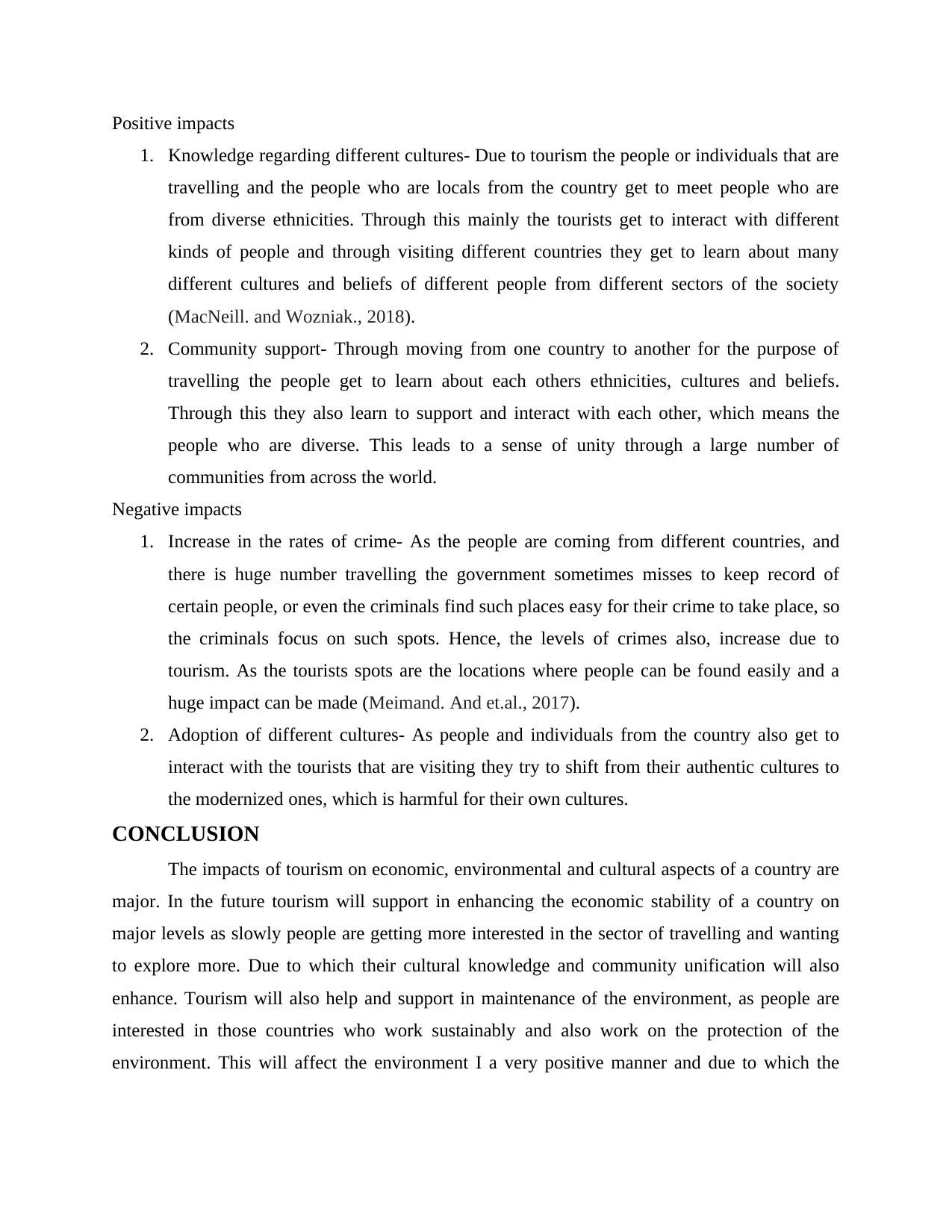
Positive impacts
1. Knowledge regarding different cultures- Due to tourism the people or individuals that are
travelling and the people who are locals from the country get to meet people who are
from diverse ethnicities. Through this mainly the tourists get to interact with different
kinds of people and through visiting different countries they get to learn about many
different cultures and beliefs of different people from different sectors of the society
(MacNeill. and Wozniak., 2018).
2. Community support- Through moving from one country to another for the purpose of
travelling the people get to learn about each others ethnicities, cultures and beliefs.
Through this they also learn to support and interact with each other, which means the
people who are diverse. This leads to a sense of unity through a large number of
communities from across the world.
Negative impacts
1. Increase in the rates of crime- As the people are coming from different countries, and
there is huge number travelling the government sometimes misses to keep record of
certain people, or even the criminals find such places easy for their crime to take place, so
the criminals focus on such spots. Hence, the levels of crimes also, increase due to
tourism. As the tourists spots are the locations where people can be found easily and a
huge impact can be made (Meimand. And et.al., 2017).
2. Adoption of different cultures- As people and individuals from the country also get to
interact with the tourists that are visiting they try to shift from their authentic cultures to
the modernized ones, which is harmful for their own cultures.
CONCLUSION
The impacts of tourism on economic, environmental and cultural aspects of a country are
major. In the future tourism will support in enhancing the economic stability of a country on
major levels as slowly people are getting more interested in the sector of travelling and wanting
to explore more. Due to which their cultural knowledge and community unification will also
enhance. Tourism will also help and support in maintenance of the environment, as people are
interested in those countries who work sustainably and also work on the protection of the
environment. This will affect the environment I a very positive manner and due to which the
1. Knowledge regarding different cultures- Due to tourism the people or individuals that are
travelling and the people who are locals from the country get to meet people who are
from diverse ethnicities. Through this mainly the tourists get to interact with different
kinds of people and through visiting different countries they get to learn about many
different cultures and beliefs of different people from different sectors of the society
(MacNeill. and Wozniak., 2018).
2. Community support- Through moving from one country to another for the purpose of
travelling the people get to learn about each others ethnicities, cultures and beliefs.
Through this they also learn to support and interact with each other, which means the
people who are diverse. This leads to a sense of unity through a large number of
communities from across the world.
Negative impacts
1. Increase in the rates of crime- As the people are coming from different countries, and
there is huge number travelling the government sometimes misses to keep record of
certain people, or even the criminals find such places easy for their crime to take place, so
the criminals focus on such spots. Hence, the levels of crimes also, increase due to
tourism. As the tourists spots are the locations where people can be found easily and a
huge impact can be made (Meimand. And et.al., 2017).
2. Adoption of different cultures- As people and individuals from the country also get to
interact with the tourists that are visiting they try to shift from their authentic cultures to
the modernized ones, which is harmful for their own cultures.
CONCLUSION
The impacts of tourism on economic, environmental and cultural aspects of a country are
major. In the future tourism will support in enhancing the economic stability of a country on
major levels as slowly people are getting more interested in the sector of travelling and wanting
to explore more. Due to which their cultural knowledge and community unification will also
enhance. Tourism will also help and support in maintenance of the environment, as people are
interested in those countries who work sustainably and also work on the protection of the
environment. This will affect the environment I a very positive manner and due to which the
⊘ This is a preview!⊘
Do you want full access?
Subscribe today to unlock all pages.

Trusted by 1+ million students worldwide

tourism will also increase of a particular country. This report precisely discusses the meaning of
contemporary tourism and the economic, environmental and socio-cultural impacts of tourism.
contemporary tourism and the economic, environmental and socio-cultural impacts of tourism.
Paraphrase This Document
Need a fresh take? Get an instant paraphrase of this document with our AI Paraphraser

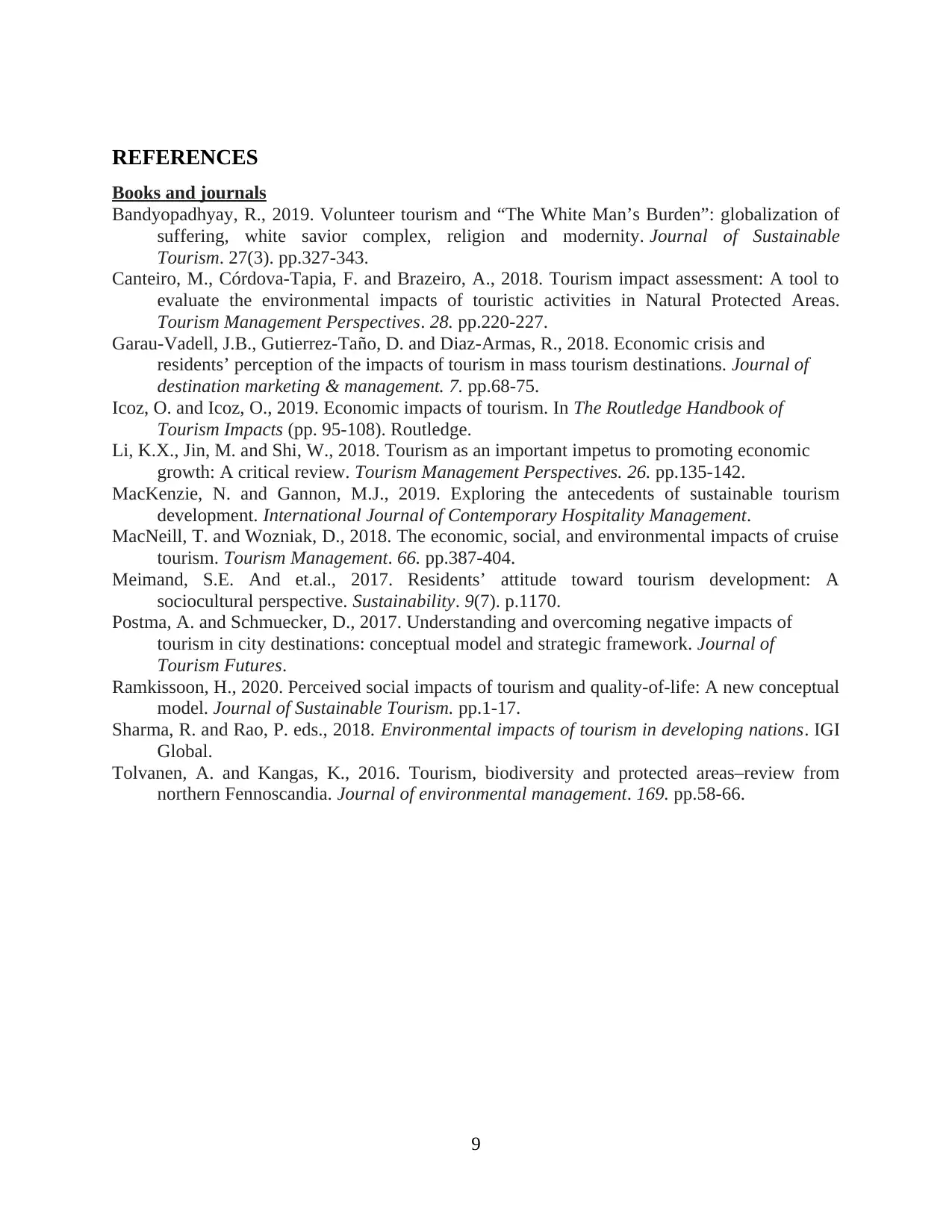
REFERENCES
Books and journals
Bandyopadhyay, R., 2019. Volunteer tourism and “The White Man’s Burden”: globalization of
suffering, white savior complex, religion and modernity. Journal of Sustainable
Tourism. 27(3). pp.327-343.
Canteiro, M., Córdova-Tapia, F. and Brazeiro, A., 2018. Tourism impact assessment: A tool to
evaluate the environmental impacts of touristic activities in Natural Protected Areas.
Tourism Management Perspectives. 28. pp.220-227.
Garau-Vadell, J.B., Gutierrez-Taño, D. and Diaz-Armas, R., 2018. Economic crisis and
residents’ perception of the impacts of tourism in mass tourism destinations. Journal of
destination marketing & management. 7. pp.68-75.
Icoz, O. and Icoz, O., 2019. Economic impacts of tourism. In The Routledge Handbook of
Tourism Impacts (pp. 95-108). Routledge.
Li, K.X., Jin, M. and Shi, W., 2018. Tourism as an important impetus to promoting economic
growth: A critical review. Tourism Management Perspectives. 26. pp.135-142.
MacKenzie, N. and Gannon, M.J., 2019. Exploring the antecedents of sustainable tourism
development. International Journal of Contemporary Hospitality Management.
MacNeill, T. and Wozniak, D., 2018. The economic, social, and environmental impacts of cruise
tourism. Tourism Management. 66. pp.387-404.
Meimand, S.E. And et.al., 2017. Residents’ attitude toward tourism development: A
sociocultural perspective. Sustainability. 9(7). p.1170.
Postma, A. and Schmuecker, D., 2017. Understanding and overcoming negative impacts of
tourism in city destinations: conceptual model and strategic framework. Journal of
Tourism Futures.
Ramkissoon, H., 2020. Perceived social impacts of tourism and quality-of-life: A new conceptual
model. Journal of Sustainable Tourism. pp.1-17.
Sharma, R. and Rao, P. eds., 2018. Environmental impacts of tourism in developing nations. IGI
Global.
Tolvanen, A. and Kangas, K., 2016. Tourism, biodiversity and protected areas–review from
northern Fennoscandia. Journal of environmental management. 169. pp.58-66.
9
Books and journals
Bandyopadhyay, R., 2019. Volunteer tourism and “The White Man’s Burden”: globalization of
suffering, white savior complex, religion and modernity. Journal of Sustainable
Tourism. 27(3). pp.327-343.
Canteiro, M., Córdova-Tapia, F. and Brazeiro, A., 2018. Tourism impact assessment: A tool to
evaluate the environmental impacts of touristic activities in Natural Protected Areas.
Tourism Management Perspectives. 28. pp.220-227.
Garau-Vadell, J.B., Gutierrez-Taño, D. and Diaz-Armas, R., 2018. Economic crisis and
residents’ perception of the impacts of tourism in mass tourism destinations. Journal of
destination marketing & management. 7. pp.68-75.
Icoz, O. and Icoz, O., 2019. Economic impacts of tourism. In The Routledge Handbook of
Tourism Impacts (pp. 95-108). Routledge.
Li, K.X., Jin, M. and Shi, W., 2018. Tourism as an important impetus to promoting economic
growth: A critical review. Tourism Management Perspectives. 26. pp.135-142.
MacKenzie, N. and Gannon, M.J., 2019. Exploring the antecedents of sustainable tourism
development. International Journal of Contemporary Hospitality Management.
MacNeill, T. and Wozniak, D., 2018. The economic, social, and environmental impacts of cruise
tourism. Tourism Management. 66. pp.387-404.
Meimand, S.E. And et.al., 2017. Residents’ attitude toward tourism development: A
sociocultural perspective. Sustainability. 9(7). p.1170.
Postma, A. and Schmuecker, D., 2017. Understanding and overcoming negative impacts of
tourism in city destinations: conceptual model and strategic framework. Journal of
Tourism Futures.
Ramkissoon, H., 2020. Perceived social impacts of tourism and quality-of-life: A new conceptual
model. Journal of Sustainable Tourism. pp.1-17.
Sharma, R. and Rao, P. eds., 2018. Environmental impacts of tourism in developing nations. IGI
Global.
Tolvanen, A. and Kangas, K., 2016. Tourism, biodiversity and protected areas–review from
northern Fennoscandia. Journal of environmental management. 169. pp.58-66.
9
⊘ This is a preview!⊘
Do you want full access?
Subscribe today to unlock all pages.

Trusted by 1+ million students worldwide
1 out of 9
Related Documents
Your All-in-One AI-Powered Toolkit for Academic Success.
+13062052269
info@desklib.com
Available 24*7 on WhatsApp / Email
![[object Object]](/_next/static/media/star-bottom.7253800d.svg)
Unlock your academic potential
Copyright © 2020–2025 A2Z Services. All Rights Reserved. Developed and managed by ZUCOL.



